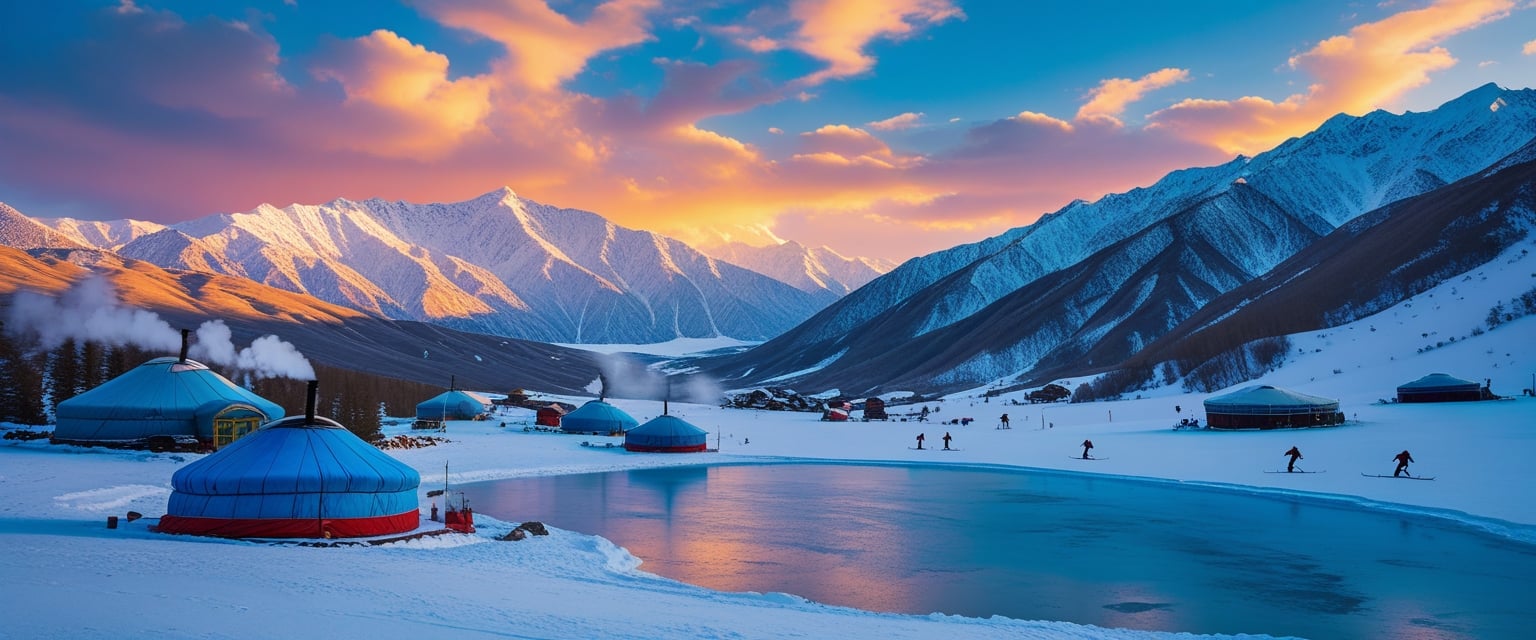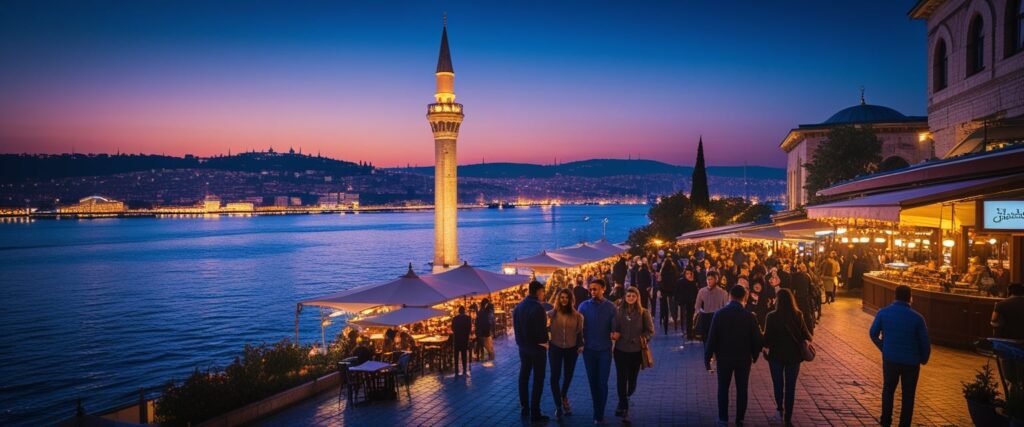Best Places in Kyrgyzstan for an Epic Winter Trip are perfect for travelers seeking both adventure and culture, from skiing in Karakol to relaxing in Issyk-Kul’s hot springs. Kyrgyzstan turns into a breathtaking wonderland when winter arrives, making it a dream destination for adventurous travelers. From snowy mountains and frozen lakes to nomadic traditions and hot springs, the country offers experiences that are both thrilling and cultural. If you’re planning your cold-season getaway, discovering the Best Places in Kyrgyzstan for an Epic Winter Trip will help you uncover hidden gems and unforgettable adventures. Whether it’s skiing in Karakol, soaking in Issyk-Kul’s hot springs, or riding horses across frozen valleys, every corner of Kyrgyzstan has something unique to offer.
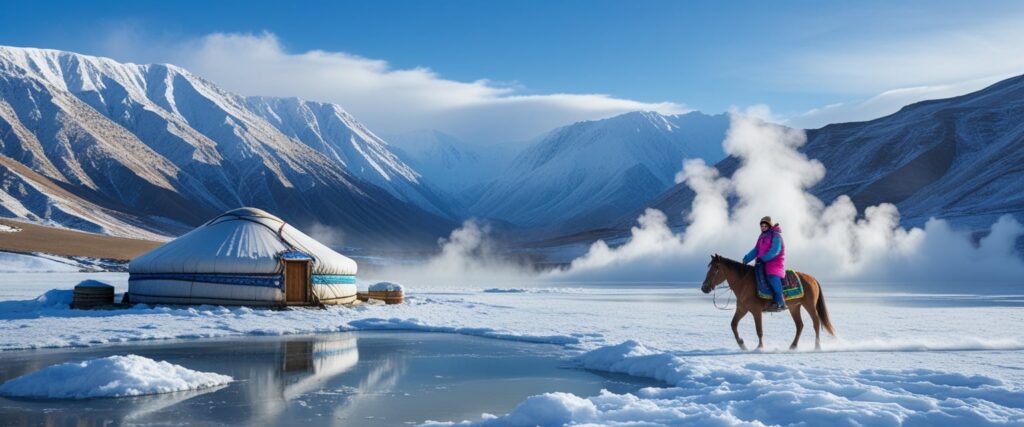
Travelers seeking both adventure and relaxation will find that the Best Places in Kyrgyzstan for an Epic Winter Trip strike the perfect balance. This guide highlights top destinations, activities, and tips to ensure your winter holiday is both memorable and seamless. For those eager to experience authentic culture and stunning scenery, the Best Places in Kyrgyzstan for an Epic Winter Trip provide everything from adrenaline-filled sports to cozy yurt stays.
Table of Contents
Best Places in Kyrgyzstan for an Epic Winter Trip
Kyrgyzstan transforms into a snow-covered escape during the colder months, offering both adventure and cultural experiences. Yes, Kyrgyzstan is an excellent winter destination with ski resorts, frozen lakes, hot springs, and unique nomadic traditions to explore. With its dramatic mountain ranges and authentic local life, the country provides a mix of outdoor activities and cultural encounters that few places can match.
Travelers can enjoy skiing at resorts like Karakol, spend nights in traditional yurts, or watch ancient sports such as eagle hunting and Kok Boru. The landscapes, from Issyk Kul’s icy shores to remote valleys in Jyrgalan, become even more striking under a blanket of snow.
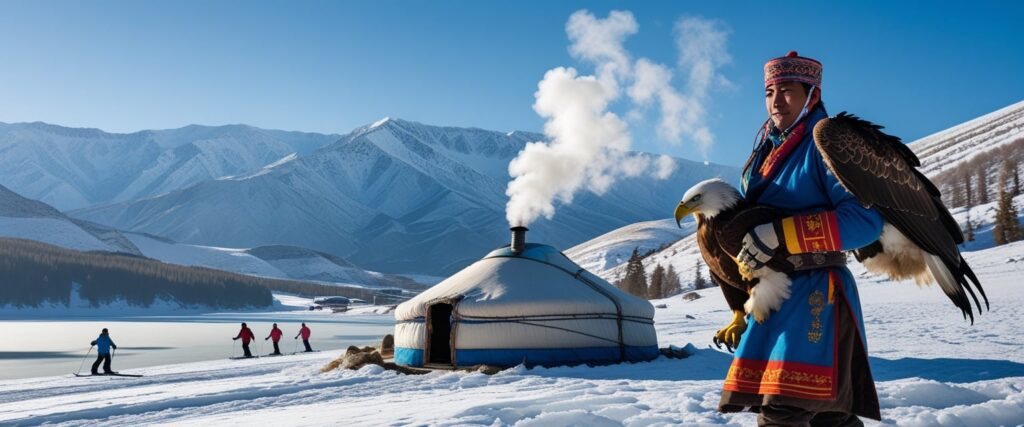
This guide highlights the best winter destinations, activities, and hidden gems across the country while also covering practical travel tips. It shows how to make the most of a trip during December and January, what to expect from the weather, and where to find the most memorable experiences.
Top Winter Destinations in Kyrgyzstan
Kyrgyzstan offers snowy mountains, frozen lakes, and cultural spots that combine outdoor adventure with local traditions. Travelers can ski, hike, soak in hot springs, or stay in yurts while enjoying some of the best places to visit in Kyrgyzstan during winter.
Lake Issyk-Kul: Winter Magic and Hot Springs
Lake Issyk-Kul, the world’s second-largest alpine lake, stays ice-free even in the coldest months. Its unique mineral-rich waters and surrounding snowy peaks create a striking winter setting.
Visitors often head to Cholpon-Ata and nearby villages for access to hot springs and sanatoriums. These natural pools provide warmth while snow covers the Tien Shan mountains.
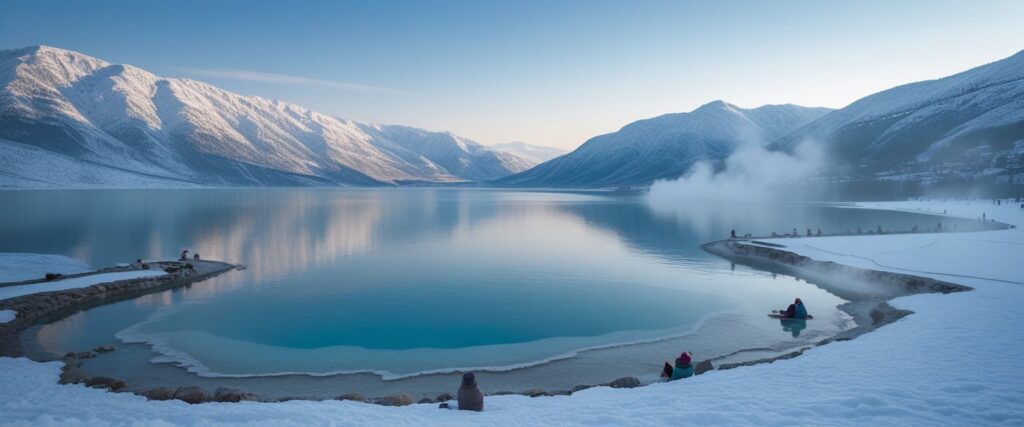
The lake area is also known for cultural sites, including petroglyphs and small museums. Winter brings fewer tourists, making it easier to explore the lakeside towns and enjoy the calm atmosphere.
For those interested in combining wellness with scenery, Issyk-Kul is one of the top winter destinations in Kyrgyzstan.
Karakol: Skiing, Culture, and Cuisine
Karakol, on the eastern edge of Issyk-Kul, is Kyrgyzstan’s main ski hub. The Karakol Ski Base offers slopes for beginners and advanced skiers, with affordable passes compared to other ski resorts worldwide.
Beyond skiing, Karakol is known for its wooden Orthodox church, Dungan Mosque, and Soviet-era architecture. The town mixes Russian, Kyrgyz, and Dungan influences, giving it a unique cultural atmosphere.

Food is another highlight. Travelers often try ashlyan-fu, a cold noodle dish, and hearty lagman. Destination Karakol promotes food tours and cultural events that help visitors connect with the local community.
Karakol combines winter sports, history, and food, making it one of the best places to visit in Kyrgyzstan in winter.
Ala-Archa National Park: Snowy Adventures Near Bishkek
Just 40 km south of Bishkek, Ala-Archa National Park is a popular day trip for winter travelers. The park sits in the Tian Shan mountains and is known for its deep valleys, glaciers, and alpine forests.
Winter activities include snowshoeing, hiking, and photography. Trails such as the Ak-Sai waterfall hike remain accessible, though conditions can be icy.

The park’s proximity to the capital makes it easy to reach by car or taxi. Visitors often spend a few hours exploring the snowy landscapes before returning to Bishkek for the evening.
Ala-Archa is one of the most accessible places to visit in Kyrgyzstan in winter, offering mountain scenery without long travel times.
Song Kul: Frozen Lake and Nomadic Experiences
Song Kul, a high-altitude lake at 3,000 meters, freezes solid in winter. The wide plateau surrounding the lake becomes a remote but rewarding destination for travelers seeking quiet landscapes.
Most nomadic families leave the area in winter, but some yurt camps remain open for visitors. These camps allow travelers to experience Kyrgyz hospitality, traditional meals, and horseback riding across snowy pastures.
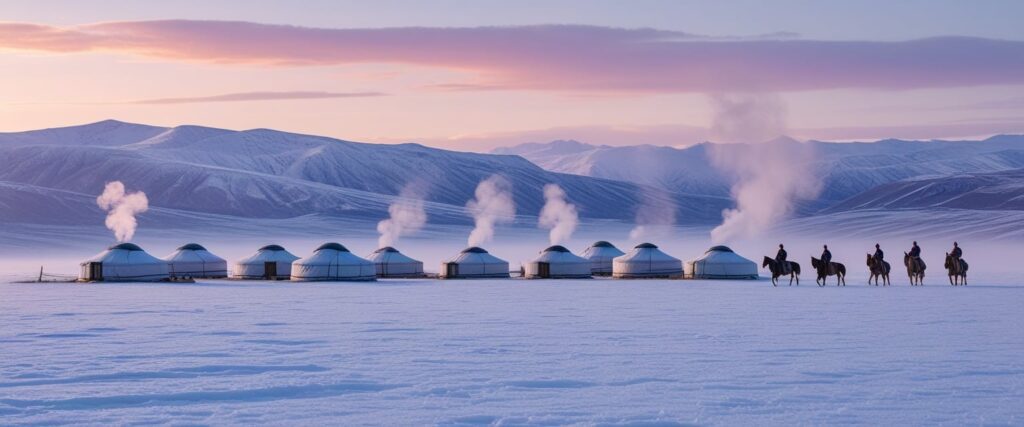
The lake is harder to reach in winter, often requiring a 4×4 vehicle or guided tour. Its isolation, however, makes it one of the most memorable winter destinations in Kyrgyzstan.
Song Kul combines frozen beauty with authentic nomadic culture, giving travelers a rare look at life in the mountains during snow season.
Unmissable Winter Activities and Experiences
Kyrgyzstan offers a mix of mountain sports, cultural traditions, and natural relaxation during the colder months. Visitors can enjoy snow-filled adventures in the Tian Shan, explore nomadic heritage, and unwind in hot springs surrounded by alpine scenery.
Skiing and Snowboarding in the Tian Shan Mountains
The Tian Shan Mountains stretch across much of Kyrgyzstan and provide reliable winter snow. Resorts like Karakol Ski Resort in the Karakol Valley are popular for their varied slopes, affordable lift passes, and easy rental options. With a vertical drop of over 700 meters, the resort suits both beginners and advanced riders.
Backcountry enthusiasts often head to Jyrgalan, a small village that has become a hub for ski touring and snowboarding. Unlike Karakol, Jyrgalan has no lifts, so visitors use snowshoes, splitboards, or snowmobiles to reach untouched slopes. The reward is quiet landscapes and panoramic views, including peaks that border Kazakhstan.
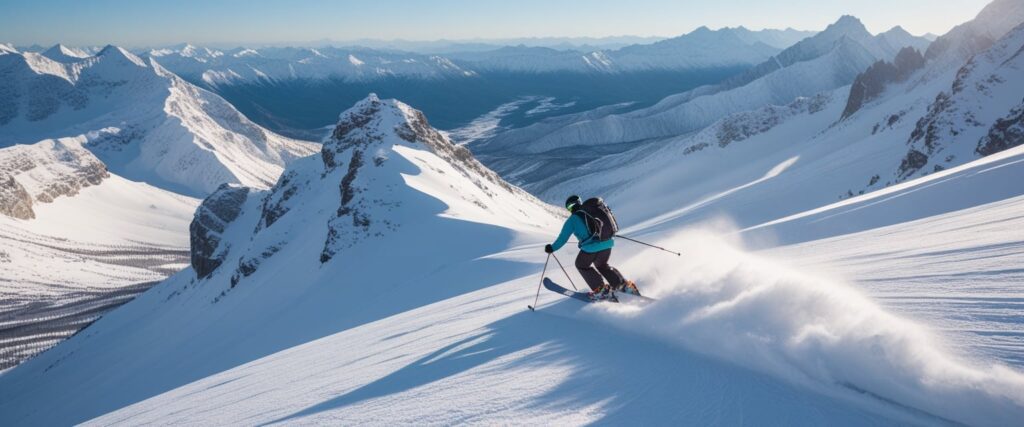
Other areas near Bishkek and Jalpak Tash also provide skiing, but Karakol remains the most developed option. For those seeking both convenience and adventure, combining Karakol’s groomed runs with Jyrgalan’s backcountry terrain offers a balanced winter trip.
Horseback Riding and Winter Trekking
Horseback riding remains central to Kyrgyz identity, and it continues through the winter months. In regions like Kochkor and around Song Kul Lake, travelers can ride horses across snowy plateaus guided by local herders. The experience highlights nomadic traditions while also making it easier to cover long distances in cold conditions.
Winter trekking is another way to explore the Tian Shan. Routes around Karakol Valley and Jeti Oguz are accessible for guided day hikes, often using snowshoes. Trails reveal frozen waterfalls, pine forests, and red sandstone cliffs dusted with snow.
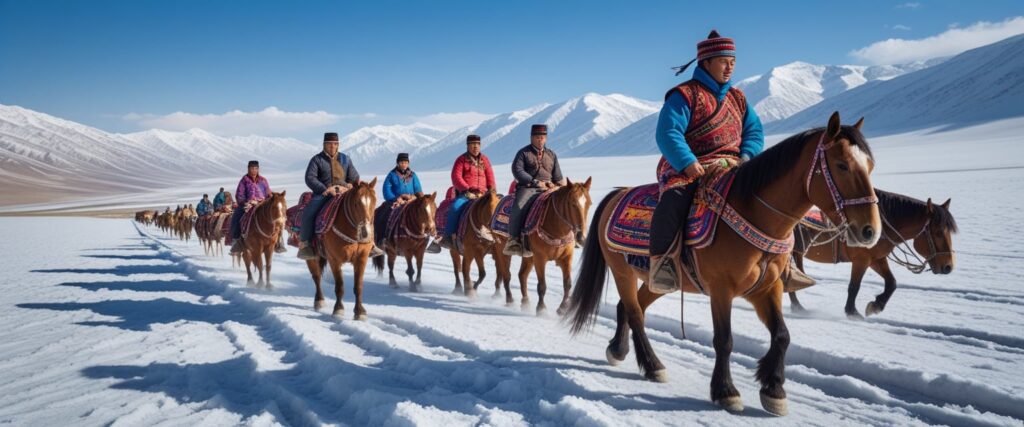
Multi-day treks are possible for experienced hikers, though conditions can be harsh. Local community-based tourism offices arrange guides, equipment, and homestays, ensuring safe passage through the mountains.
Yurt Stays and Nomadic Culture
Spending a night in a yurt introduces travelers to a core part of Kyrgyz nomadic life. Unlike summer camps, only a few yurt stays remain open in winter, but they provide a warm and authentic setting. Camps in Boz Uchuk Valley and near Jyrgalan are known for their remote locations and mountain views.
Inside, wood stoves keep the yurts heated, and thick felt insulation holds warmth through the night. Guests often share meals such as maida manty (steamed dumplings) and fresh bread with their hosts.
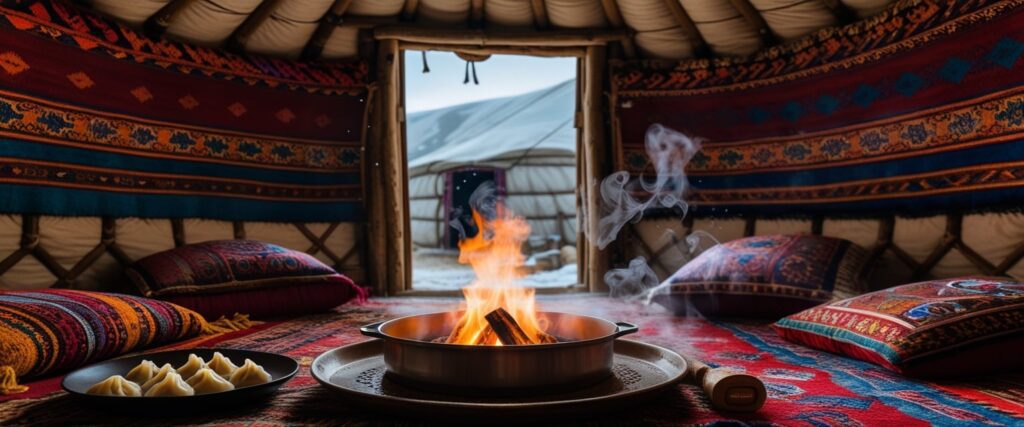
Staying in a yurt also offers easy access to winter sports. Many camps are located near ski touring routes, so visitors can combine cultural immersion with outdoor activity.
Hot Springs and Relaxation
After long days outdoors, soaking in a hot spring is a common way to recover. The most well-known spot is Altyn Arashan, a valley near Karakol reached by a short trek or vehicle ride. Pools here are fed by natural mineral water and surrounded by snow-covered peaks.
Closer to town, the Ak-Suu Kench Hot Springs provide easier access. Facilities include outdoor pools with different temperatures and basic amenities like lockers and a small café. Entry fees are low, making it a practical option for most travelers.

Hot springs in Kyrgyzstan combine relaxation with scenic views. Whether in a remote valley or near a village, they provide a warm contrast to the cold alpine environment.
Hidden Gems and Off-the-Beaten-Path Spots
Kyrgyzstan’s winter landscapes extend beyond the well-known resorts and popular cities. Remote valleys, historic caravanserais, and cultural heartlands offer quieter experiences with strong ties to local traditions and nature.
Jyrgalan Valley: Backcountry Paradise
Jyrgalan Valley sits east of Issyk-Kul Lake and is known for its untouched backcountry terrain. In winter, the valley transforms into a hub for ski touring, snowshoeing, and freeride adventures. Unlike large resorts, the area offers wide open slopes without crowds.
Visitors often stay in family-run guesthouses, where home-cooked meals and warm hospitality are part of the experience. The community has developed small-scale tourism that supports locals while keeping the valley authentic.
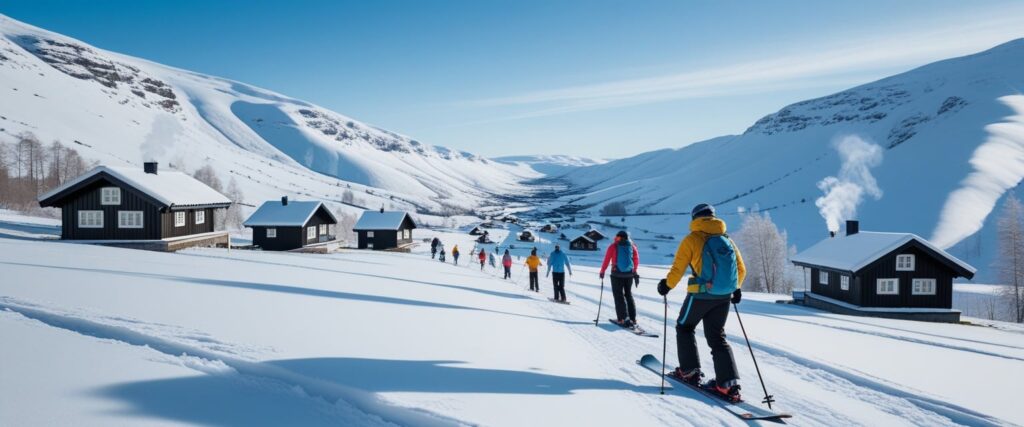
Snow conditions remain reliable from December through March. Travelers looking for a quieter alternative to Karakol often find Jyrgalan a better fit for extended winter stays.
Tash Rabat: Silk Road Winter Adventure
Tash Rabat, a 15th-century stone caravanserai, lies deep in the At-Bashy mountains near the Chinese border. In winter, snow blankets the structure, creating a striking view against the white landscape.
The site once hosted traders on the Silk Road and today allows visitors to explore its preserved stone chambers. Staying in nearby yurts gives travelers a sense of nomadic life even in freezing conditions.
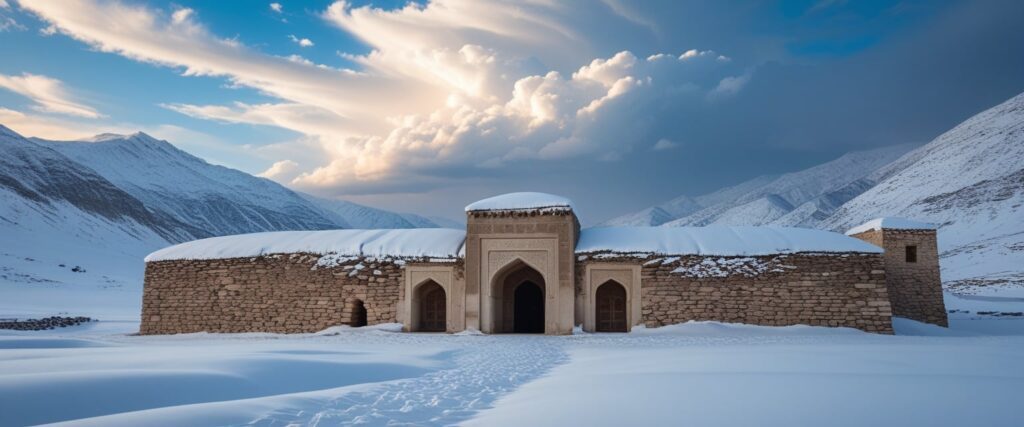
Reaching Tash Rabat in winter requires preparation, as roads can be icy and remote. Those who make the trip often combine it with horse treks or short hikes in the surrounding valleys. The experience blends history with outdoor exploration in a rugged setting.
Arslanbob: Snowy Walnut Forests
Arslanbob is famous for its vast walnut forests, the largest natural walnut grove in the world. In winter, the forests become quiet trails for snowshoeing, cross-country skiing, and guided walks.
The town itself has a strong Uzbek influence, reflected in its food, markets, and hospitality. Staying with local families in guesthouses offers cultural immersion alongside outdoor activities.
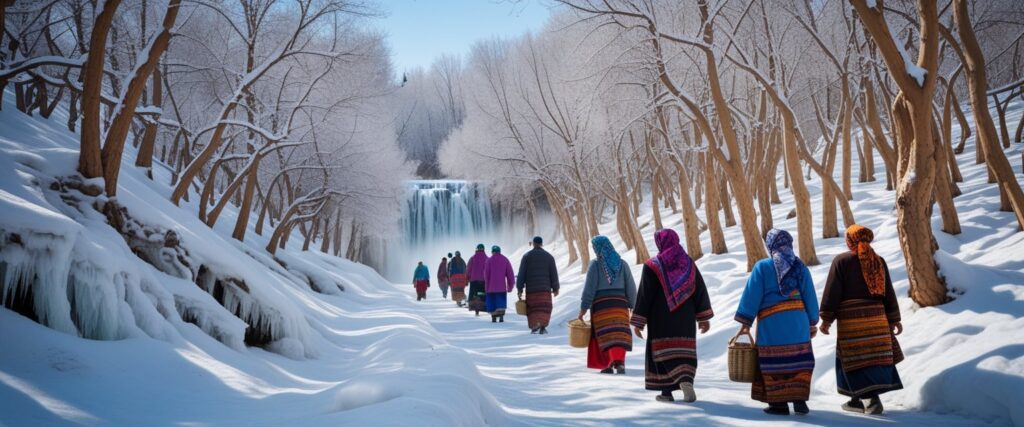
Winter in Arslanbob is less about downhill skiing and more about slow exploration. Snow-covered orchards, frozen waterfalls, and mountain views make it a scenic retreat for travelers seeking both nature and culture.
Osh and Fergana Valley: Cultural Encounters
Osh, Kyrgyzstan’s second-largest city, remains active in winter and serves as the gateway to the Fergana Valley. The city is known for Sulaiman-Too Sacred Mountain, traditional bazaars, and its mix of Kyrgyz and Uzbek culture.
Winter markets in Osh are lively, with seasonal produce, dried fruits, and handwoven crafts. The food scene is also a highlight, offering plov, samsa, and other Central Asian dishes that provide warmth during cold months.
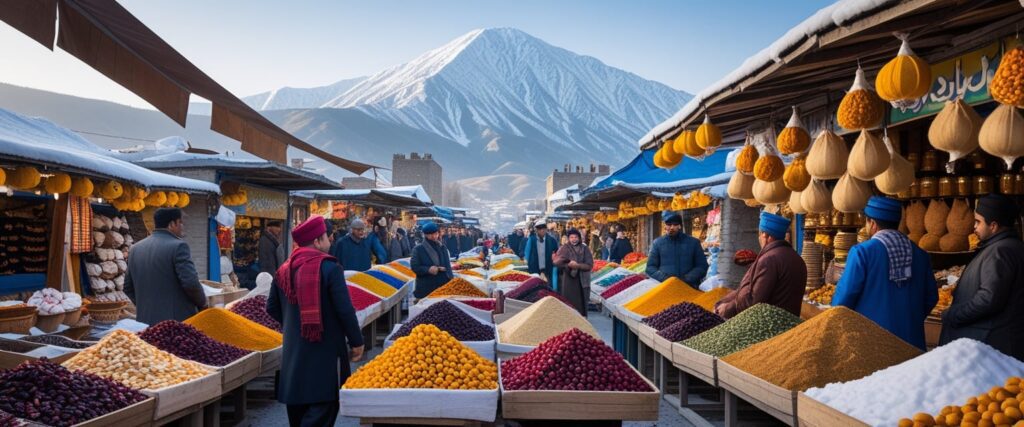
The wider Fergana Valley offers cultural depth rather than snow sports. Villages and towns in the region allow travelers to experience music, crafts, and traditions that differ from northern Kyrgyzstan, making it a meaningful stop on a winter journey.
Essential Winter Travel Tips for Kyrgyzstan
Traveling through Kyrgyzstan in winter means dealing with cold temperatures, snowy roads, and remote landscapes. Visitors need to prepare for the weather, plan safe transportation, and pack the right gear to make the trip both comfortable and practical.
How Cold Does Kyrgyzstan Get in Winter?
Kyrgyzstan’s winters are cold, especially in the mountains. In Bishkek and the Chuy Region, daytime temperatures often range from -5°C to -10°C (23°F to 14°F) in January, though nights can drop lower. Higher-altitude areas like Son-Kul Lake or Karakol can fall below -20°C (-4°F).
Snowfall is heavy in mountain regions, making places like Ala-Archa National Park or Issyk-Kul Lake scenic but challenging. Cities such as Bishkek remain more accessible, with central spots like Ala-Too Square still active in winter, hosting seasonal events and ice sculptures.
Travelers should expect shorter daylight hours and icy conditions. Wind chill can make the air feel colder, so dressing in layers is essential.
Getting Around Safely in Snow Season
Road travel in winter requires extra caution. High mountain passes may close due to snow, and icy roads are common. Hiring a local driver or joining a guided tour is often safer than renting a car. Public transport runs between Bishkek and nearby towns, but schedules may be delayed.
Travelers heading east toward Karakol or historic sites like Burana Tower and Suyab should plan for long drives. Winter tires and chains are necessary for private vehicles.
Domestic flights operate between Bishkek and Osh, but weather can cause cancellations. Within cities, taxis and ride-hailing apps are reliable, though snow can slow traffic. Walking in urban areas is manageable, but sidewalks may be slippery, so sturdy boots are important.
Packing and Preparation Advice
Winter packing should focus on warmth and practicality. Essential items include:
- Thermal base layers
- Insulated jacket and waterproof boots
- Wool hats, scarves, and gloves
- Moisturizer and lip balm to protect against dry air
- Portable charger for phones, as batteries drain quickly in the cold
Visitors staying in yurts or rural guesthouses should bring a sleeping bag rated for sub-zero conditions. In Bishkek, restaurants like Save the Ales offer cozy indoor spaces to warm up after exploring.
Carrying cash is useful since card payments may not work in smaller villages. A basic first aid kit and travel insurance that covers winter sports are also strongly recommended.
Conclusion
A winter journey to Kyrgyzstan is more than just a trip—it’s an adventure into snowy peaks, rich traditions, and unforgettable hospitality. By exploring the Best Places in Kyrgyzstan for an Epic Winter Trip, travelers can combine skiing, trekking, and cultural encounters with the warmth of local life. Each destination, from Song Kul’s frozen lake to Jyrgalan’s untouched slopes, offers its own magical charm.
The Best Places in Kyrgyzstan for an Epic Winter Trip not only highlight the beauty of the mountains but also immerse visitors in the nomadic lifestyle that makes the country so special. Whether you’re chasing adventure or searching for serenity, these destinations promise lasting memories. For a holiday filled with snowy landscapes, authentic traditions, and breathtaking views, look no further than the Best Places in Kyrgyzstan for an Epic Winter Trip. Start planning today, and let this Central Asian gem surprise you with its winter magic.
Frequently Asked Questions
Travelers heading to Kyrgyzstan in winter can expect snowy mountain landscapes, affordable ski resorts, and unique cultural experiences. The season brings both opportunities for outdoor adventure and the need for careful planning around weather and transport.
What are the top destinations to visit in Kyrgyzstan during winter?
Karakol is one of the most popular winter destinations, known for its ski base and proximity to Lake Issyk Kul. Jyrgalan offers a quieter mountain setting with options for ski touring and snowshoeing. Song Kul, though harder to reach, provides yurt stays and frozen lake views for those seeking a traditional nomadic experience.
Which winter activities are a must-try when in Kyrgyzstan?
Skiing and snowboarding are among the most popular activities. Visitors also enjoy horse trekking through snowy valleys, staying in yurts, and watching cultural sports like kok boru. For a slower pace, hot springs and local homestays provide warmth and relaxation.
Can you go skiing in Kyrgyzstan, and if so, where are the best spots?
Yes, Kyrgyzstan has several ski areas. Karakol Ski Base is the most developed and attracts both locals and international visitors. Jyrgalan and Suusamyr Valley are also well-regarded for backcountry skiing, offering deep snow and fewer crowds.
What are some recommended things to do in Kyrgyzstan in December and January?
Travelers often combine skiing with cultural experiences. December and January are good months to attend local festivals, visit hot springs, and explore Bishkek’s winter markets. Staying in a yurt camp or joining a guided trek adds a more immersive experience.
What travel tips should one keep in mind when visiting Kyrgyzstan in winter?
Roads can be icy, so travelers should allow extra time for transport between cities. Marshrutkas and taxis still run, but delays are possible in heavy snow. Booking homestays or guesthouses in advance is recommended since some yurt camps close for the season. Travel guides also suggest packing proper winter gear, including warm layers and waterproof boots.
How severe is the winter weather in Kyrgyzstan, and what should travelers expect?
Temperatures vary by region. Bishkek often stays just below freezing, while Karakol averages around -10°C at night. Mountain areas like Jyrgalan can drop to -20°C or colder. Snow is common from December to March, and high-altitude passes may remain snow-covered into spring.
